- Conditions of nikah
- History of marriage reform
- Basics of Nikah
- Requirements for the bride and groom
- Nikah of a Muslim with a Christian
- Nikah with an unbelieving woman
- Age of marriage for girls and boys
- Stages of wedding Smotrina
- Consent to marriage or nikah
- Seriousness of intentions
- Formula for pronouncing the introduction in nicknames
- Marriage contract
- Mahr
Nikah in Islam or nikah - translated from Arabic means “marriage” and is similar among Muslims in its meaning and effect to the terms “marriage”, “marriage”, “wedding” (in Arabic: “zawaj”, “javaz”, “ urs"). The meaning of the term nikah in Islam is interpreted as “marriage that is concluded between a man and a woman.”
Nikah is an agreement or marriage contract between a man and a woman who enter into marriage, under certain mandatory conditions.
Conditions of nikah
A man and a woman who decide to get married must have reached the age of majority according to Islam, and also have reason, that is, they must consciously be prepared for adult life and be adequately aware of the responsibility that family life places on a person.
Islam puts forward certain conditions that must be met in order for the nikah to be recognized as valid.
- The first condition for nikah is a wedding gift or mahr, which must be given to the bride by her groom. Mahr should not be confused with bride price, which is a kind of ransom paid according to Central Asian tradition to the bride's family. Mahr is a gift specifically to the bride, and not to her father or relatives, as is the case with kalym. A mahr gift is not necessarily a monetary gift, but a valuable one. In a hadith, the Prophet Muhammad ﷺ told one of his companions that he should get married, even if he does not have sufficient financial resources, and in such situations, suras from the Holy Book of the Koran can be mahr. The Scripture speaks of the need to observe mahr in order for nikah to be recognized as real.
- The second condition for nikah is that a Muslim bride can belong to the “People of the Book,” that is, be a Jew or a Christian, but a Muslim cannot marry a pagan or polytheist. A Muslim woman can only marry a Muslim man.
- The third condition for nikah: in order for the nikah to be recognized as valid, a certain formula must be pronounced in Arabic: the bride’s guardian pronounces zawwajta (“I gave in marriage”) in the past tense, and the groom says kabilta (“I accepted the marriage”), and between the utterances of these formulas there should not be a long break in time.
- The fourth condition for nikah: according to the rules of a number of madhhabs, when performing nikah during the first marriage, the bride must be present with her confidant - this is the opinion of the Hanbalis, Shafiites and Malikis, but the Hanafis believe that when concluding a marriage or nikah, even if it is the first, the bride can be present unaccompanied by a guardian or proxy.
- The fifth condition for nikah: during the conclusion of the nikah, the presence of witnesses is necessary. They can be either two men, or one man and two women, according to the Hanafi madhhab. According to Hanafi theologians, if only women are present as witnesses, then such a nikah will not be recognized as valid. Also, Shafi'is and Hanbalis, unlike Hanafis, believe that only people who deserve trust can be witnesses.
Among the mandatory conditions that must be met in order for the nikah to be considered valid are also:
- consent to the marriage of a woman and a Muslim man (the consent of the bride if the first or second nikah is being concluded is required in both cases);
- permission of the bride's guardian;
- presence of witnesses;
- payment of mahr;
- the husband's maintenance of his wife, as well as his good treatment of her;
- fulfilling marital responsibilities;
- spouse's maintenance of children.
Mandatory nikah ceremony
If you are a true Muslim, then you should follow all customs. Therefore, before the wedding, a traditional ceremony called “nikah” should be held. This ceremony is reminiscent of a Christian wedding.
This ritual goes as follows.
- To do this, you should invite a Muslim priest. He must be a believer and know the laws of the Koran well.
- The ceremony takes place in the mosque. The newlyweds go accompanied by their parents and witnesses.
- According to custom, two men must be witnesses, but according to Sharia law, the presence of two women and one man is allowed.
- People who are representatives of another religion are prohibited from staying there.
- The head must be covered with a hat. And women dress in closed Muslim dresses.
Editor's choice: Food in a limousine for a wedding: how to organize delicious dishes
Basics of Nikah
In the modern Muslim world, the nikah procedure is based on three components, following each other: on the part of the groom - a proposal for marriage, on the part of the bride - acceptance of this proposal, and on the part of the bride's confidant, who can be her father or older brother, as well as a person acting as the bride's guardian.
When concluding a nikah between a Muslim and a non-Muslim, consent can also be given by the bride’s confidant, who is not related to her, but is a Muslim - this practice is used in the case of a nikah between a Muslim and a Christian or Jewish woman.
Traditional outfits for young people
The bride's attire is always magnificent and decorated with symbolic patterns, often made of gold thread or semi-precious stones. Indian Muslim weddings combine elements of dress from both cultures. With the influence of world trends, the dress is often chosen in white, but historically for these purposes they chose fabrics of various shades and loved a variety of colors, because they were more highly valued.
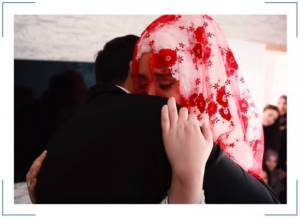
According to religious canons, the dress must cover it:
- shoulders;
- forearm;
- ears;
- hands;
- legs.
The girl's head is decorated with a veil or hijab - a traditional Islamic headscarf. Each bride chooses a style in accordance with her figure, the style of the celebration, the main thing is that it is not overly tight-fitting.
And grooms increasingly prefer a formal suit, a tuxedo, and, less often, the national dress of the country in which they live. The head is covered with a skullcap, papakha, turban, fez and other headdresses, which are common in a particular region.

Requirements for the bride and groom

Modern Muslims are not always fully aware of how to correctly interpret the term nikah and what responsibilities are assigned to spouses when concluding nikah.
Islam considers nikah to be a godly deed, permitted to every Muslim. Islam recommends that the bride and groom match in terms of social, social, financial status, as well as mutual sympathy, and similarity of types in moral and spiritual development, age characteristics, but this is not a requirement for marriage.
There are certain restrictions in Islam, which include the bride falling under the category of “mahram”, that is, if she is the groom’s mother, both biological and dairy, grandmother or daughter, sister, both biological and dairy, granddaughter, as well as niece, aunt, mother-in-law, stepmother, stepdaughter or daughter-in-law. Nikah is considered permitted if the degree of relationship between spouses is beyond the third degree.
The Holy Book of the Koran prohibits Muslim women from marrying a non-Muslim. Muslim men cannot marry unbelieving women, agnostics and atheists, as well as pagans, and Muslims are allowed to marry Christians and Jews, but it is not desirable.
If we are talking about marrying women from the “People of the Book”, Christians or Jews, in a non-Muslim country, then this is makrooh tahrim, which borders on prohibition.
A Muslim cannot cohabit with a woman without entering into a nikah with her; this is regarded as haram and adultery.
If a person who is incomplete and incompetent enters into marriage, the decision is made for him by his guardian, his master or an intermediary.
During the times of slavery, Islam also regulated the relations between masters and their slaves; in Islam, Nikah with his slave or slave was not allowed, but cohabitation with a slave was allowed to her master, but the best solution was to free the slave and marry her as a free woman with the rights of a wife, This is what the Prophet Muhammad ﷺ did with some of his wives. Marriages between slaves were allowed, but slaves were required to obtain permission from their master, and the number of wives for a slave was limited to two.
A Muslim can have a maximum of four wives, but if he wants to marry again after already having four wives, he should first divorce one of them. According to Islam, a woman is prohibited from having multiple husbands.
When choosing a bride, Islam instructs a man to pay attention to such qualities as her religiosity, as well as her character, external beauty and ability to bear children for him, as well as her origin.
How does matchmaking happen?
After meeting the bride has taken place, the next stage is matchmaking. During such a visit, all important aspects of the wedding celebration are discussed. To determine the date of the holiday, look at the Muslim wedding calendar.
Everything related to the financial issue, these responsibilities fall on the groom’s side. And also, the newlyweds are not even allowed to hold hands before the wedding. And the bride should wear only closed clothes. Therefore, he will not be able to see all the beauty of his bride.
Editor's Choice: How to Organize a Wedding Abroad: Benefits and Tips
Nikah of a Muslim with a Christian
What should a woman be like to become an ideal wife for a Muslim?
It is said that a woman from the “People of the Book” must be chaste in order for a Muslim to marry her. According to Abu Jafar ibn Jarir at-Tabari, a virtuous woman means inaccessible or chaste, that is, one who maintains her chastity, abstains and protects her genitals from debauchery.
Allah Almighty said about Maryam, the daughter of Imran, that she was chaste, preserved her chastity, that is, she preserved her genitals from the forbidden and distanced herself from debauchery. Chastity is applied here not only to women of the Book, but also to Muslim women. At-Tabari quotes the words of Allah Almighty that Muslims “are permitted chaste women from among those who believe and chaste women from among those to whom the Book was given before you.” Some scholars believed that these words imply that the People of the Book, which includes the woman whom a Muslim is planning to marry, should not be at war with Muslims.
An important condition is that a Muslim man, when planning to marry a Christian or Jewish woman, must be sure that the child who will be born to him from this woman will not be forced into unbelief in the future. That is, a Muslim should not marry a non-Muslim woman in a non-Muslim country, since in such a country his child may not be raised in Islam, he may be forced to study Christianity and be taken to church. In such countries there may also be a law according to which a woman can take a child and raise him herself in the religion of her people and according to her customs.
Dress of a Muslim woman getting married
Muslim fashion is quite different from European fashion. However, despite all the outward modesty, there is no place for ordinary elements on the dress of a Muslim bride. Often, such a dress looks both modest and luxurious at the same time, and to achieve this effect, brides put in a huge amount of effort. The elements of the dress and external image of a Muslim bride include:
- the dress itself, which is made from expensive fabrics;
- decorations on the dress, of which there can be a lot;
- long and patterned earrings;
- hijab decorated with multi-colored or plain stones.
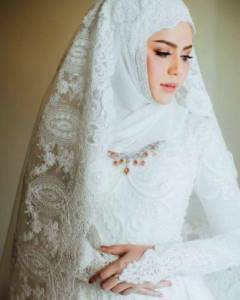
The most popular image for a Muslim bride at present is the princess image, which includes a rather fluffy skirt and an elegant corset, which is decorated with ribbons or rhinestones.
Today, they also often choose a mermaid look or an A-line dress. The fact is that Western trends are now actively being introduced into Eastern culture, so it is somewhat modified.
Among the main features of Muslim attire, it can be noted that arms, shoulders, as well as legs and back must be covered. In the bride's image, translucent sleeves are even prohibited, as is the use of lace. It is quite logical that in this case you don’t even have to think about the neckline. However, despite such strict conditions and restrictions, girls know how to emphasize their own attractiveness.
If a girl has an hourglass figure, then she can subtly emphasize the attractiveness of her curves with a mermaid wedding dress, or choose a fitted dress with a full skirt.
Interesting! Why women in the UAE still wear gold masks
The fact that the dress has long sleeves provides an excellent opportunity for many Muslim girls to decorate them to their liking. The use of lace, various ribbons, and other decorative means is allowed in the sleeves.
Depending on how much money the family has the opportunity to spend on the wedding, many girls decorate their dresses with precious and semi-precious stones. This makes the bride feel like a queen. It is worth noting separately that Muslim weddings always take place on a truly royal scale.
Age of marriage for girls and boys
Representatives of all madhhabs agree that a woman and a man entering into marriage and pronouncing the nikah formula must be adults (from Arabic “baligh”), as well as sane.
A woman who is a virgin cannot enter into nikah without the consent of her guardian, even after reaching adulthood.
Ijma or the consensus of all scholars from all madhhabs implies that the onset of menstruation and the opportunity to become pregnant and give birth to a child is sufficient to allow a woman to marry, but the age of majority is set differently by different madhhabs if menstruation is absent or boys do not have wet dreams.
The Hanbalis and Shafi'is consider the age of majority to be fifteen for both boys and girls, while the Malikis set the age of majority at seventeen. The Hanafis consider the age of majority to be eighteen years old, while the Jafaris set the age of majority for girls at nine years and for boys at fifteen. There is an opinion among some modern scholars among Shiites that girls should not enter into nikah at such an early age.
How does a Tatar wedding take place?
A Tatar wedding is a bright and very complex phenomenon of Tatar life. Many scientific works are devoted to the study of family and wedding Tatar traditions. The fact that the majority of Tatars are Muslims dictates that the wedding be held according to the laws of Islam, and the rich national customs of the ancient people make the Tatar wedding original and interesting.
Matchmakers - kudalar - go to visit the bride from the groom's side. Mostly these are respected people. Among them there may be close relatives of the young man who go to the girl’s family house to find out more about her and also exchange gifts with the bride’s relatives. If the girl likes the young man, then she gives him a white embroidered scarf through intermediaries. In turn, the Kudalar give the girl perfume and jewelry, as well as all kinds of sweets. All this is certainly beautifully packaged and decorated with bows and ribbons. The groom's relatives also do not leave empty-handed. They need to give the young man several handkerchiefs, shirts decorated with patterns embroidered by the bride, as well as several trays of pastries and sweets, which are also beautifully packaged. Then the matchmakers discuss the engagement date and leave.
Nikah is a Muslim marriage. concluded in accordance with Shariah. Nikah stipulates that both future spouses have converted to Islam, that they have reached marriageable age and are not related, and also, according to Nikah, the man’s financial situation should allow him to pay the ransom and support his family, more details Muslim traditions, customs and holidays
After the end of the festive feasts, the newlyweds, as a rule, should visit the bridal bathhouse. For their departure, special pancakes are prepared for the son-in-law. When the son-in-law eats pancakes, he must quietly put a coin under the plate of pancakes. Then the bridesmaids arrange a viewing for the groom, subject him to various comic tests and take him to the wedding chambers. The newlywed stays in his wife's house for four days, makes multiple offerings to relatives, and gives a particularly expensive gift to his wife. The bride's return gifts consist of her handicrafts.
The final stage of the wedding is the wife moving to her husband's house and wedding feasts with the groom's relatives. They greet the bride, observing customs: they place an inverted fur coat or pillow under the young woman’s feet, dip her hands in flour, treat her with freshly baked bread and honey, present some animal as her property, and show her the way to the spring.
Stages of marriage

The basis of the procedure for performing an Islamic marriage goes back to the pre-Islamic family-legal complex, and it was developed by Muslim scholars who lived in the first centuries of the existence of Islam.
The stages of an Islamic marriage or nikah include:
- The rite of hitba or matchmaking, an agreement when the groom, independently or through his proxy, makes an offer to the father, guardian or proxy of the bride, and also agrees on mahr, that is, a gift or property that the future husband allocates to his wife, and also negotiates other conditions with them, which are mentioned in the marriage contract.
- Nikah or the actual entry of the bride and groom into a marriage relationship, and only after the Nikah will the marriage be considered complete.
- The ceremony of zifaf or handing over of the bride to the groom's house, followed by the wedding celebration, that is, walima and urs. If the bride is not yet an adult, then her transfer to her husband's house will take place only when the bride reaches adulthood. The prenuptial agreement may be announced during the wedding celebration. Also at this moment, the payment of mahr, or part of the mahr, occurs.
Some theologians, relying on a weak hadith, see it as desirable for the wedding ceremony to take place in a mosque. The conclusion of a marriage contract takes place in front of witnesses.
The wedding ceremony itself depends on the wealth of the couple, their position in society and on how local customs among Muslims dictate how to conduct the ceremony.
It is advisable that friends or relatives be invited to the wedding ceremony in the mosque and the wedding meal.
Modern Muslims register their nikah with a marriage notary or mazun.
In a number of Islamic countries there is a law limiting the number of polygamous marriages, although their percentage has never been high, or it completely prohibits such marriages.
Urs or ritual is a wedding celebration that should be fun and joyful, and this joy should be shared with the newlyweds by their loved ones and relatives. Entertainment during marriage celebrations should be innocent in nature and delight others, decorating the celebration itself. During wedding celebrations, prohibited actions that are contrary to Islam should not be performed, that is, one should not drink alcohol, allow women to spend time together with men, as well as dance and sing songs.
Bride
A Muslim who is going to get married should first look at the woman he is going to marry, so that the woman can get to know the man, and he gets a clear idea about his future wife. A Muslim man can look at the woman he plans to marry, and he can do this repeatedly, but he can only look at her face and hands. Some scholars, including al-Awza'i and Imam Ahmad, were of the opinion in this matter that a man can see a woman's face, hands, as well as her neck, feet and arms.
Consent to marriage or nikah
According to the majority of madhhabs, except for the Hanafis, in order for the nikah to be recognized as valid, it is necessary that each of the parties give voluntary consent, and if the bride is a virgin, then her guardian must also give consent.
This is confirmed by hadiths, which say that the nikah of a woman who marries without the consent of her guardian is invalid . Regarding those women who have already been married, it is said that they have the right to decide for themselves.
Seriousness of intentions
All Sunni madhhabs believe that one cannot pronounce the marriage formula or the divorce formula as a joke, but even in this case the nikah will be considered valid. Marriage can also be concluded in sign language. The Jafarites believe that in both the first and second cases the nikah will not be considered valid.
Formula for pronouncing the introduction in nicknames
The formula of the marriage contract must contain: the proposal itself or ijab, which is made by the bride or her guardian, the response of the groom or his representative, which is called kabul. Pronunciation of this formula is mandatory for the nikah to be recognized as valid. Jurists of the Hanbali and Maliki madhhabs believe that this formula should include the words zavvajt or anqaht, when the bride says “I am married,” as well as kabilta, that is, the groom’s phrase, meaning “I agree.” These madhhabs require that a response to the proposal be made immediately, or the marriage will be regarded as invalid.
According to Hanafi rules, other words and expressions may be used, but they must imply the act of marriage. Also, the Hanafis do not demand an immediate response to the proposal. According to the Shafiites, it is wajib, that is, it is mandatory that the formula use words that, from a grammatical point of view, are derived from the words naqaha or zawaja. All madhhabs agree that the formula can be pronounced in the language that is native to the bride and groom if they cannot pronounce these phrases in Arabic.
Marriage contract
Hanbalis believe that a marriage contract will be valid if the groom undertakes that he will not force his wife to leave her city, as well as the country, will not force her to go on business trips with him, if he undertakes not to take a second and subsequent wives. Hanafis, Shafi'ites and Malikis believe that this condition is not valid, but a marriage with such a condition written in the marriage contract is valid.
Mahr
Mahr is the property that a husband gives to his wife upon marriage. The size and content of the mahr at the time of the conspiracy is determined by agreement of representatives of both parties. If the nikah ends in widowhood, then the mahr remains with the wife, just as if the marriage ends in divorce on the initiative of the husband.
The mahr may contain something of value that may be subject to ownership: money, valuable property, precious metals and stones.
Shariah establishes the minimum amount of mahr, and if its size is not agreed upon at the time of concluding the marriage contract, then the spouse pays the minimum amount. The Hanafi madhhab sets the minimum size of mahr as 33.6 grams of silver, 4.8 grams of gold or an amount equivalent to their value. The Malikis set the minimum size of a mahr at three dirhams, while the Jafarites recognize as mahr anything that has some value.
If there has already been intimacy between the spouses, then the husband is obliged to pay this amount. It is prohibited to pay a lesser amount, even if this was agreed upon in the marriage contract. Nikah cannot be terminated if mahr is not paid by representatives of any Sunni madhhabs, with the exception of the Maliki one.
When exactly the mahr is to be paid is determined at the time of concluding the marriage contract: this is done either immediately, or the mahr is paid in installments, or the mahr is paid upon divorce.
If the mahr is not paid, then the wife has the right to a faskh or conditional divorce, which will last until the mahr is paid.
Pre-wedding Muslim traditions and rituals
For people of other faiths, a Muslim wedding seems like a mysterious, mysterious and calm event. However, this is not just one day in the life of the newlyweds; it will begin long before the first visit of the matchmakers to the house of the future bride.
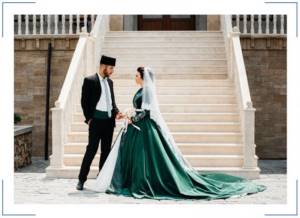
Search for the bride
In the modern world, young Muslims meet at common holidays, family celebrations where guests are invited, as well as in any public place. It is not difficult to recognize a radical Muslim among girls - she is distinguished by a hijab or a covered head, but this is not a prerequisite.
Previously, this responsibility was taken on by the mother or sister of the groom, trying to choose the ideal candidate. This is due to the fact that the girls’ social circle was limited to a female group - at work, at the dinner table, in conversation. It was there that one could look for a humble, pious and, of course, beautiful-faced possible bride.
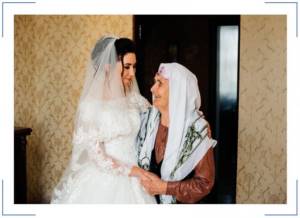
Meeting future spouses
In some communities, the tradition has actually been preserved of coming to a girl’s house with gifts to meet her and express the groom’s desire to take her as his wife. After seven days, she had to make a decision about whether she agreed to share her life with this person. If there was a refusal, all the gifts were returned with it.
One-on-one dating is not practiced among Muslims. It is customary to communicate among relatives or friends, and only on important topics. When the guy met, he could only see the silhouette, and even then, the dress could not emphasize it, as well as his hands and face. These parameters gave an impression of the lady’s attractiveness and health.

The fascinating tradition “Henna Night”
It takes place just before the wedding. The bride's friends, both married and single, gather for the ceremony and farewell “party.” A woman who must be happily married applies various patterns to the girl’s legs and arms.
All symbols carry a special meaning and send happiness, peace and love into the home of a young family. The quality of the henna remains important - the longer the design lasts, the stronger the marriage will be. In addition, the wife is forbidden to do anything around the house until the paint comes off the skin.
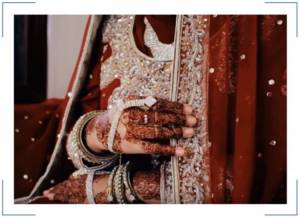
Return to contents
The wedding night
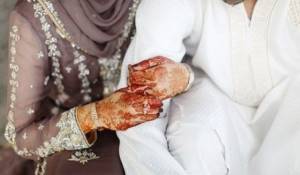
The wedding night is not just the entry of spouses into an intimate relationship: it is a special ritual with its own rules and regulations.
It is mustahabb for the groom to treat his wife to sweets and drinks that are permitted on the first wedding night. Before entering into an intimate relationship with his wife, the husband must place his hand on his wife’s forehead, say the basmala, and then say the dua: “O Allah! Truly, I ask You for good from her and all the good things that You have given her! And I resort to You from her evil and from all the evil that You have endowed her with.”
After this, the spouses must jointly perform a prayer of two rak'ahs, reading “O Allah, bless me in my relationship with my wife (husband) and her (him) in my relationship. O Allah, establish goodness between us and separate us kindly during separation!”
When the wife is a virgin, that is, she has not been married before, then the husband, if he has other wives, should spend seven nights with her after concluding the nikah, but if the wife was already married before, then the husband should spend three nights with her. nights .
The custom of showing proof that a spouse was a virgin exists among some Islamic nations, but this is not part of Islamic etiquette and is prohibited in Sharia law.
What do we know about the features of a Muslim wedding?

In the understanding of many, the Islamic religion is a complete restriction of women's rights, a submissive existence. But this is a misinterpretation. After all, rights and responsibilities are also assigned to the head of the family, that is, the man. Yes, the Koran says that a man has the right to polygamy. But in order to get at least one wife, you need to have a tidy sum. Today, Muslim women wear European clothes under their veils, often showing them off not only at home. And in some states, Muslim women are even allowed to wear knee-length skirts, but at the same time worn over trousers.
Types of Muslim marriages
Zawaj, nikah, urs is a marriage in which the groom pays mahr to his bride, and the wives who received mahr are equal to each other.
Some Muslim movements have several types of marriage:
- temporary marriage, that is, one that is concluded for a certain period of time. This type of nikah is considered invalid by four Sunni madhhabs; temporary marriage is prohibited in Islam. Shiites recognize temporary marriage as permissible.
- polygamous marriage, that is, one when a man has several wives at the same time, but their number should not exceed four. When divorcing one of his four wives, a man can remarry, but he should not marry if the ex-wife has not yet completed the period of iddah, and between them there is a right to renew the marriage, which exists if there has not been a three-time divorce between them. Polygyny in Islam is permitted and is preferable to monogamous marriage.
- a fictitious marriage, that is, one when a man, having divorced his wife three times - not having the right to return her back according to Sharia, consciously resorts to the path with her when his ex-wife marries another man, entering into an intimate relationship with him, and then divorces him in order to remarry her former husband. In such situations, Muslims enter into fictitious marriages or nikah tahlil in order to subsequently divorce, but Islam prohibits this type of marriage and this is a sin.
The innocence of the bride
Not only the wedding attire of a Muslim bride must comply with the rules prescribed in the Koran, but also her behavior. In Muslim countries, girls are not allowed to have intimate relations with a man before the Nikah ceremony. The Koran prohibits even the slightest physical contact: hugging and holding hands. The girl must be innocent, because this is an honor for her and her family. For Muslims, the wedding night is the first moment when a husband and wife can touch each other.
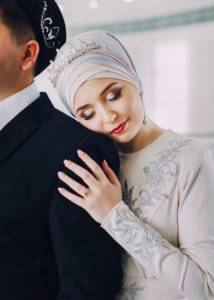
Holidays and religious customs of Muslims
Followers of Islam celebrate all holidays according to the lunar calendar. The beginning of knowledge, which is marked by a special date - the day of migration (08/15/622) of Muhammad from Mecca to Medina. Eid al-Adha and Kurban Bayram are considered special and significant annual holidays. There is also an important weekly holiday - namaz. Muslims also celebrate celebrations that appeared before the birth of Islam.
Eid al-Adha

70 days after the end of Uraza (fasting), the date of celebration of the first largest Muslim celebration begins. On the eve of the holiday, pilgrims climb Mount Arafat. On the day of the sacrifice, they perform a seven-fold circumambulation of the Kaaba (tawaf) and a symbolic ritual - throwing stones. The history of the appearance of Kurban Bayram is closely associated with one of the sacred legends: Ismail, under the punishment of the angel Gabriel, was going to sacrifice his son. Allah prepared this test for him to test whether his faith was true. At the last moment, God took pity on the unfortunate father, and the sacrifice was replaced by a ram. Since then, every Muslim family slaughters a camel, sheep or ram on this day. They keep only 1/3 of the animal’s meat for themselves, the rest is distributed to those in need.
Preparations for the celebration begin long before the onset of Kurban Bayram. In the previous 20 days, it is prohibited to organize special events, have fun, appear in public in new outfits, or visit a hairdresser. xHousewives always bake ritual bread on the eve of the celebration. On holiday mornings, services are held in mosques. After this, the family feast begins. The main dishes of the holiday are prepared from the meat of an animal sacrificed. Eid al-Fitr lasts 3 days. These days, Muslims visit the graves of deceased relatives and distribute alms.
Eid al Adha

The holiday of breaking the fast is celebrated the day after the end of Ramadan. The date of the celebration is 1 Shawallah. During Eid al-Fitr, adherents of Islam, instead of the usual greeting, address each other with the phrase “Eid Mubarak!” Translated, this phrase means “Blessed Holiday!”
The celebration of Eid al-Adha begins with Eid Namaz (ritual prayer). After this ceremony, they set the tables, go to visit, and have fun. On this day, it is customary to ask for forgiveness, treat all children with sweets, give gifts to relatives and friends, and distribute alms to those in need.
Daily five times prayer
The primary and obligatory ritual for every Muslim is prayer. The prayer is said daily 5 times a day. It is not necessary to go to a mosque for this; you can say sacred prayers at home or at work. This applies to all days of the week except Friday. On this day, adherents of Islam, regardless of age and gender, are required to visit the mosque. Friday prayer is called Juma prayer.
Nowruz

One of the most ancient and brightest holidays is the Day of the Vernal Equinox. This celebration began to be celebrated long before the advent of Islam. Nowruz has ancient Iranian roots and is associated with the cult of the Sun and the legendary prophet Zarathushtra. The first mention of this holiday was found in the holy book “Avesta”.
In ancient times, this day was considered the beginning of a new year, according to the lunar calendar. The ancient traditions of Muslims are still honored in some countries. On the eve of Navruz, houses are thoroughly cleaned and festive dishes are prepared. In the morning, men and women, dressed in beautiful clothes, organize a procession (gulgardoni): they walk along the street with bouquets of the first spring flowers and sing songs dedicated to the arrival of spring and the beginning of sowing work.
At a gala family dinner, there are always 7 dishes prepared from ingredients whose names begin with “sin”, and the national sweet – malt halva (sumanak). A mirror is placed on the table, and candles are placed on both sides of it. Their number corresponds to the number of family members.
Wedding decoration in traditional oriental style
Decorating a wedding in an oriental style involves using beautiful textile draperies in bright colors such as fuchsia, turquoise, blue, scarlet, orange, lilac, etc.
The Damascus pattern is often used in decoration - symmetrically arranged floral motifs, which are often chosen as a theme for a stylish celebration - a wedding in the Damascus style.
Flowers for decorating tables at an oriental wedding are chosen to be large and bright: callas, lilies, orchids, roses, peonies, gladioli. Seats for guests are most often low sofas or ottomans, abundantly strewn with bright pillows.
Modern Muslim wedding
The holy book of Muslims - the Koran - allows men to have not one, but several wives at the same time. In fact, it turns out that even one wife is very expensive to support. Therefore, not every representative of the stronger sex gets married even once. To “play” a Muslim wedding, the groom needs at least five thousand dollars. However, gifts for the future wife and her relatives are not included in this amount.
After the wedding, the newly-made husband should not relax either, because he will have to feed the family on his own. The wife, even if she works, has every right to spend her salary on her feminine whims. These financial responsibilities of a man are indicated as a separate clause in the marriage contract. The wishes of the wife are also written there, for example, expensive gifts every year and so on. The Law also calls for respecting the wife's needs and respecting her. For the reasons described above, many men in Arab countries remain single for a long time. They like to hit on foreign tourists because they are not so strict towards them.










